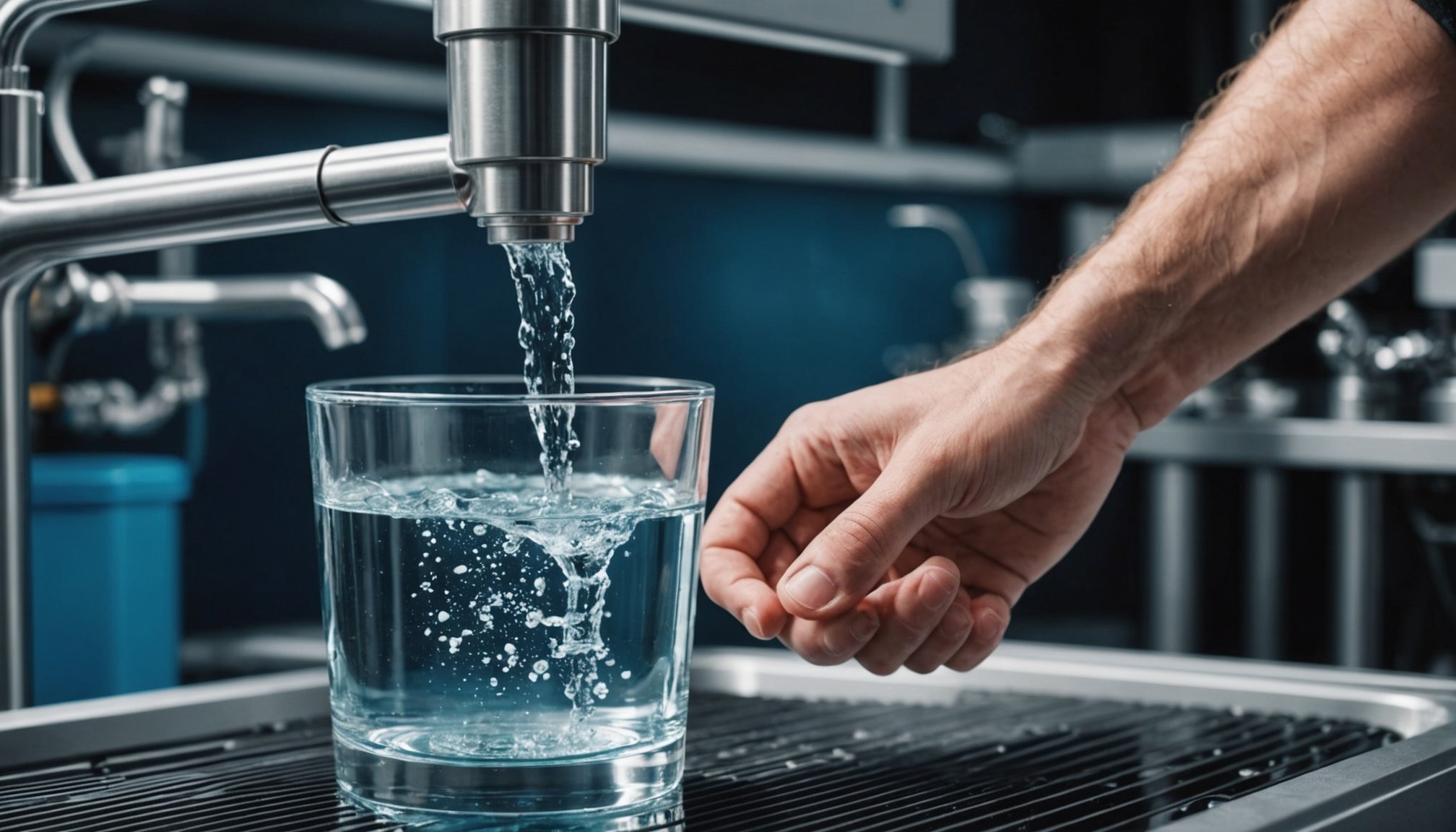Transforming Water Cleanliness: How Nanofiltration Technology is Shaping the Future of Purification Methods
In the quest for clean and safe drinking water, advanced technologies have emerged to tackle the challenges of water purification. Among these, nanofiltration stands out as a versatile and efficient method that is revolutionizing the way we treat water. Here, we delve into the world of nanofiltration, exploring its principles, applications, and how it compares to other purification methods like reverse osmosis.
What is Nanofiltration?
Nanofiltration is a membrane filtration process that operates at a molecular level, making it highly effective for removing specific contaminants from water. Unlike traditional filtration methods, nanofiltration uses semi-permeable membranes with pore sizes between 1 to 10 nanometers. This allows it to filter out particles such as divalent and larger monovalent ions, organic molecules, and certain salts, while permitting smaller molecules like water and some minerals to pass through[1][2][5].
How Nanofiltration Membranes Work
Nanofiltration membranes operate under pressure, forcing water through the semi-permeable membrane. This process retains unwanted particles and contaminants, including:
- Hardness-causing ions: Calcium and magnesium ions that contribute to water hardness.
- Organic compounds: Pesticides, certain bacteria, and other organic materials.
- Larger monovalent salts: Depending on the membrane specifications, these salts can also be removed.
The selective retention of ions by nanofiltration membranes is based on the Donnan effect, which ensures that the membrane has a specific affinity for certain ions, making it highly effective for targeted contaminant removal[1][2].
Additional reading : Elevate your social media game with an ai post generator
Applications of Nanofiltration
Nanofiltration is a highly flexible technology with a wide range of applications across various industries.
Drinking Water Purification
Nanofiltration is used to remove harmful contaminants like pesticides and organic materials from drinking water, while retaining essential minerals that improve the taste and health benefits of the water. This makes it an ideal solution for communities looking to enhance their water quality without stripping it of beneficial minerals[1].
Food and Beverage Production
In the dairy industry, nanofiltration is utilized for whey protein concentration and lactose removal. It is also applied in juice production to retain natural flavors while removing impurities. This technology helps in producing high-quality food products with minimal loss of nutrients[1][4].
Industrial Water Treatment
Nanofiltration is employed to treat process water, reduce scaling in boilers, and recover valuable materials from wastewater. It is particularly useful in industries where water quality is critical for operations and product quality[1].
Agricultural Applications
Nanofiltration helps desalinate water for irrigation while preserving nutrients beneficial for crops. This is especially important in areas where water scarcity is a significant issue, as it allows for the efficient use of available water resources[1].
Nanofiltration vs Reverse Osmosis: Key Differences
When comparing nanofiltration and reverse osmosis, several key differences emerge.
Filtration Capabilities
- Nanofiltration: Removes specific contaminants like divalent and large monovalent ions while allowing smaller solutes to pass through.
- Reverse Osmosis: Provides nearly total desalination, removing up to 99% of dissolved salts, including both harmful and beneficial substances[1][2][4].
Operating Pressures
- Nanofiltration: Operates at lower pressures compared to reverse osmosis, making it more energy-efficient for applications that don’t require complete desalination.
- Reverse Osmosis: Requires higher pressures, especially for seawater desalination, which can range from 40 to 82 bar (600 to 1200 psi)[1][4].
Water Retention
- Nanofiltration: Retains beneficial minerals in the water.
- Reverse Osmosis: Strips water of nearly all dissolved substances, including essential minerals[1][2].
Choosing the Right Membrane: NF vs RO
Selecting between nanofiltration and reverse osmosis depends on the water source, treatment goals, and energy considerations.
When to Use Nanofiltration
- Partial Filtration: Ideal for applications requiring partial filtration, such as softening water or removing specific organic contaminants.
- Mineral Retention: Preferred when retaining beneficial minerals in the water is important.
- Energy Efficiency: More energy-efficient due to lower operating pressures[1].
When to Use Reverse Osmosis
- High-Purity Water: Suitable for scenarios demanding high-purity water with total contaminant removal, such as seawater desalination or ultrapure water production in industries.
- Comprehensive Purification: Used when the removal of nearly all dissolved substances is necessary[1][4].
Real-World Applications and Case Studies
Industrial Wastewater Treatment
A case study on recycling industrial wastewater with nanofiltration highlights the effectiveness of this technology. By using different nanofiltration membranes (NF90, NF270, XN45, XLE), researchers were able to select the most suitable membrane for treating wastewater based on parameters such as water flux, salt rejection, and COD (Chemical Oxygen Demand) values. The NF90 membrane was found to perform optimally at moderate temperatures and high flow rates, demonstrating the potential of nanofiltration in industrial wastewater treatment[3].
Emerging Technologies for PFAS Treatment
Per- and polyfluoroalkyl substances (PFAS) are a significant concern in water purification due to their persistence and health risks. Nanofiltration and reverse osmosis are among the advanced technologies being used to remove PFAS from water.
Nanofiltration for PFAS Removal
Nanofiltration membranes with pore sizes between 1 to 10 nanometers can filter out larger PFAS molecules while permitting the passage of smaller ions. This makes nanofiltration a scalable and high-efficiency solution for PFAS removal, although it requires pretreatment and post-treatment processes to manage the PFAS-laden water filtered out during the process[5].
Sustainable and Eco-Friendly Aspects
Nanofiltration is not only effective but also offers several sustainable and eco-friendly advantages.
Energy Efficiency
Nanofiltration operates at lower pressures compared to reverse osmosis, which makes it more energy-efficient. This is particularly important in the context of global efforts to reduce energy consumption and rely more on renewable energy sources.
Water Conservation
By treating wastewater and making it reusable, nanofiltration contributes to water conservation. This is crucial in addressing water scarcity issues, especially in remote areas where access to clean water is limited.
Minimal Waste Generation
Nanofiltration generates less waste compared to other purification methods, making it a more environmentally friendly option. This is especially relevant when combined with other technologies like Surface Active Foam Fractionation (SAFF), which can further reduce the volume of waste generated from PFAS-laden reject water[5].
Practical Insights and Actionable Advice
For those considering implementing nanofiltration in their water treatment systems, here are some practical insights and actionable advice:
Assess Your Water Source and Treatment Goals
Before choosing between nanofiltration and reverse osmosis, it is crucial to assess the quality of your water source and your treatment goals. If you need to remove specific contaminants while retaining beneficial minerals, nanofiltration might be the better choice.
Consider Energy Consumption
Nanofiltration is generally more energy-efficient than reverse osmosis. If reducing energy consumption is a priority, nanofiltration could be the more sustainable option.
Consult with Experts
Given the complexity of water treatment systems, consulting with experts can help determine the best technology for your specific needs. They can provide insights into the optimal operating parameters and membrane selection based on your water quality and treatment objectives.
Nanofiltration is a powerful tool in the arsenal of water purification technologies. Its ability to selectively remove contaminants while retaining beneficial minerals makes it an ideal solution for various applications, from drinking water purification to industrial wastewater treatment. As the world grapples with water scarcity and the need for sustainable solutions, nanofiltration stands out as a technology that can help ensure clean and safe water for future generations.
Comparative Table: Nanofiltration vs Reverse Osmosis
| Parameter | Nanofiltration (NF) | Reverse Osmosis (RO) |
|---|---|---|
| Filtration Accuracy | Between ultrafiltration and reverse osmosis | Nearly total desalination |
| Pore Size | 1-10 nanometers | 0.0001-0.001 micrometers |
| Operating Pressure | Lower pressures (typically 2-10 bar) | Higher pressures (typically 2-82 bar) |
| Water Retention | Retains beneficial minerals | Strips water of nearly all dissolved substances |
| Energy Consumption | More energy-efficient | Higher energy consumption |
| Applications | Partial filtration, drinking water purification, food and beverage production, industrial water treatment | High-purity water needs, seawater desalination, ultrapure water production |
| Contaminant Removal | Specific contaminants like divalent ions, organic molecules, and certain salts | Nearly all dissolved substances, including heavy metals and bacteria |
Detailed Bullet Point List: Benefits of Nanofiltration
- Selective Contaminant Removal: Removes specific contaminants while allowing beneficial minerals to pass through.
- Energy Efficiency: Operates at lower pressures, making it more energy-efficient.
- Water Conservation: Treats wastewater and makes it reusable, contributing to water conservation.
- Minimal Waste Generation: Generates less waste compared to other purification methods.
- Versatile Applications: Used in drinking water purification, food and beverage production, industrial water treatment, and agricultural applications.
- Eco-Friendly: Offers a sustainable solution with lower energy consumption and minimal environmental impact.
- Improved Water Quality: Enhances water quality by removing harmful contaminants while retaining beneficial minerals.
- Scalable Solutions: Provides scalable solutions for PFAS removal and other contaminant removal needs.
By understanding the capabilities and applications of nanofiltration, we can make informed decisions to optimize our water treatment systems, ensuring clean and safe water for all. As we move forward in addressing the challenges of water purification, nanofiltration stands as a beacon of innovation and sustainability.







